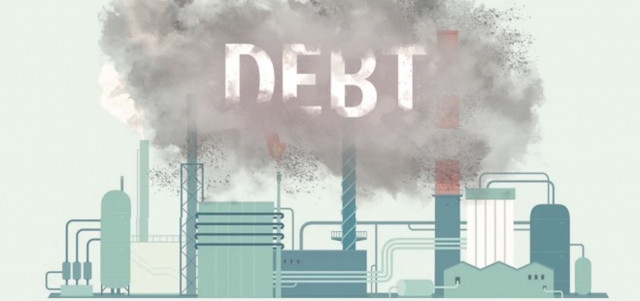Revisiting “D” word: Pakistan should opt for debt restructuring
External debt servicing burden country faces today is one of the highest in the world

In its recent media release, the independent Economic Advisory Group (EAG) has encouraged the government to consider initiation of debt restructuring negotiations to avoid the risk of “disorderly default”.
It clarified that “this will…come at the expense of meeting additional conditionalities agreed with the creditors, who will bear the cost of restructuring. None of these options are without economic pain, but a well-managed restructuring process can allow the economy to recover faster than otherwise.”
In this article, I will advocate this view that given the trade-off, the Ministry of Finance should seriously consider debt restructuring.
To provide a context, Pakistan’s external debt servicing has increased from $6.5 billion in FY13 to close to $26 billion in FY23. This is equivalent to 65% of Pakistan’s exports (estimated at $40 billion in FY23) and 37% of exports and remittances.
In 2013, Pakistan’s external debt servicing was only 20% of exports. The external debt servicing burden (as a percentage of exports and remittances) that Pakistan faces today is one of the highest in the world.
The finance minister has repeatedly maintained that Pakistan will not consider debt restructuring and will honour its external debt servicing. So far, he has managed to deliver on his promises.
It seems that he is pursuing a two-pronged strategy: one is reliance on friendly countries like China and Saudi Arabia. Last week’s army chief visit to Saudi Arabia and a telephonic contact between the premiers of China and Pakistan must be related to the same strategy.
The second part of his strategy seems to secure additional funding from external sources, especially the Geneva conference, for flood rehabilitation.
Pakistan is seeking $16 billion of grants and debt under this head, from which it has received about $4 billion already. This may be sufficient to secure external debt servicing for FY23 without the need of any restructuring.
Although the international agencies are demanding strict control over the planned spending, money, in the end, is fungible.
However, if Pakistan’s hopes of securing significant additional external funding for flood rehabilitation are not fulfilled, then the reliance on expectations from friendly countries will become critical.
Also, pressure to increase electricity tariff and fuel surcharge will be difficult to resist, which will be detrimental to the cost of living and the dwindling political capital of PML-N.
Alternatively, we propose that Pakistan should sit down with all creditors to agree on a new schedule of external debt servicing and at the same time lift administrative controls on import and import payments immediately.
Once we do it, business activities will restore and economic output will begin to gain momentum. While trade deficit may increase as a result, this should not worry us.
About 90% of Pakistan’s imports are non-luxury in nature. It means that it is very costly to control imports without the risk of an overall economic slowdown. We have already witnessed it in the last quarter of 2022.
Any calls for import substitution at the policy level should be strictly discouraged, while markets may be encouraged to become more competitive.
Importantly, this strategy will minimise the gap between the open market and black market exchange rate. Once this is done, the remittance flow through banking channels will not decrease and exporters will be encouraged to realise their receivables sooner than later.
This will bring a substantial increase in the monthly dollar inflow, which will provide an additional cushion to Pakistan’s forex reserves, thus giving some degree of confidence to the policymakers, and to the market.
Debt restructuring will also decrease the pressure on the government to increase electricity tariffs or petroleum levy, though in the end, we will need to respect international prices.
There will be genuine apprehensions of a further downgrade by the international credit rating agencies in the case of debt restructuring. This concern is not well-placed.
First, Pakistan’s bond has already been downgraded to the junk status despite timely payments on Eurobonds in December 2022. This was in the making since the middle of 2022, owing to the catastrophic fiscal decisions made by the ousted PTI government.
In this context, the finance ministry under Miftah-Dar deserves credit for reducing the risk of default at least in the recent past.
That does not preclude the risk of a disorderly default in the future. The fact that banks are dishonouring LCs of importers is a default at least at the private-sector level.
The banks are claiming difficulty in release of dollars due to administrative controls by the central bank. Dar has made it public that while he is not going to change the SBP autonomy status, he believes that this has gone too far.
Ultimately, credibility, predictability and transparency in economic decision-making is the most important strategy for any government. This should be rules-based and not based on discretion.
Economic stability can be ensured by sticking to these rules and by institutionalising economic governance.
As the EAG press release reminds us, policymakers must acknowledge the difficult choices the country faces and overcome policy paralysis to avoid the dire consequences of a disorderly default.
The writer is the executive director of PRIME, an independent economic think tank based in Islamabad
Published in The Express Tribune, January 9th, 2023.
Like Business on Facebook, follow @TribuneBiz on Twitter to stay informed and join in the conversation.


















COMMENTS
Comments are moderated and generally will be posted if they are on-topic and not abusive.
For more information, please see our Comments FAQ